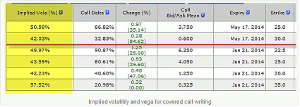Because option premium amounts are impacted mostly by the implied volatility of the underlying security, you should pay close attention to it, says option expert Alan Ellman of TheBlueCollarInvestor.com.
Covered call writing generates monthly cash flow by selling short-term options. The main factor in determining the amount of this premium is the implied volatility (IV) of the underlying security. The effect that IV has on the premium is known as vega, one of the option Greeks.
What is Vega?
Vega is the expected change in the value of an option with a 1% change in implied volatility whether up or down. It is expressed in decimal form (.040) and represents cash amount per share. As with the other Greeks, it is based on all other pricing factors remaining the same. Calls and puts both have positive vega amounts, so that if implied volatility increases, the option value on both will rise by the vega amount. If implied volatility decreases the option value will fall by the vega amount. A change in implied volatility or vega does not require an associated change in stock price. Vega has its greatest dollar impact on at-the-money strikes and its greatest percentage impact on out-of-the-money strikes. Also, the greater the time to expiration, the higher the vega.
A stock’s implied volatility can vary dramatically from its historical volatility (actual price fluctuation as observed over a period of time. Also known as statistical volatility). It can also change quickly and dramatically and is considered the most significant price factor in option value. In addition, implied volatility is rarely the same through the various strike prices and expiration dates as shown in the figure below:
The red line separates strikes prices for Gaslog Ltd. (GLOG), a stock currently on our Premium Watch List, May and June expirations. Note how the IV differs from strike to strike and between expiration dates as well.
Using Vega When Selling Covered Calls
We know that vega is mainly impacted by implied volatility and the higher the vega, the higher option premium, all other pricing factors remaining constant. We also know that the greater the implied volatility, the higher the risk. We can use this knowledge to tailor our trading to our personal risk tolerance and overall market assessment. My goal for initial, one-month returns is 2-4% per month. More aggressive investors will set higher goals and vice-versa. Another factor to consider is that implied volatility rises prior to news announcements and therefore will enhance our risk exposure. That is why we avoid selling covered calls prior to earnings announcements.
When to Consider Options with High Vegas
• Higher Personal Risk Tolerance
• Bullish Market Outlook
• Strong and Confirming Chart Technicals
When to Favor Options with Low Vegas
• Low Personal Risk Tolerance
• Bearish or Volatile Market Outlook
• Chart Technical Mixed
This assessment and determination can be accomplished without looking up the vega stats for every option on every stock although many brokerages provide options chains that incorporate much of this information. I make my investment decisions in a quick and user-friendly manner. I set a goal based on initial option premium return (time value only). My goal as stated above is 2-4% per month for these initial option returns. I have found over the years that adhering closely to this parameter will allow me to generate favorable monthly returns and minimize the risk of higher-vega options. In strong bull markets, I may get a bit more aggressive and set higher monthly goals and in strong bear markets I may set lower monthly goals.
Call Vega Example
• BCI Call Option has a Value of $4 and a Vega of 0.06
• Current Contract Value = $400
• Implied Volatility Increases by 1%
• The New Contract Value Would be $406, a Gain of $6
• If implied Volatility Decreases by 2%, the Contract Value Would Decline to $388 (400 – $12)
Summary
Our option premium amounts are impacted mostly by the implied volatility of the underlying security. The impact that IV has on the option value is measured by the Greek known as vega. We can tailor our covered call writing plan to meet our personal risk tolerance needs and overall market assessment by factoring in vega as a key determining factor.
By Alan Ellman of TheBlueCollarInvestor.com






















